University Brand Management Report: Nike's Comprehensive Analysis
VerifiedAdded on 2023/06/03
|14
|4220
|487
Report
AI Summary
This report provides a comprehensive brand audit of Nike, a leading global athletic brand. It begins with an executive summary and introduction, outlining the report's objectives and scope. The brand inventory section analyzes Nike's brand portfolio, positioning, mantra, elements, SWOT analysis, and strategic marketing elements. The brand exploratory section delves into consumer awareness, brand associations, competitive actions, consumer-brand relationships, and recommended improvements to brand equity. The report also includes a brand leverage strategy, references, and conclusions drawn from the analysis. The report examines Nike's strengths, such as its strong brand image and marketing capabilities, while also addressing weaknesses like overdependence on the US market and increasing competitive pressure. Opportunities for growth include digitalization, product innovation, and international expansion. The report concludes that brand inventory and exploratory analysis are sufficient for understanding Nike's brand, and it recommends leveraging strategies for better brand management.
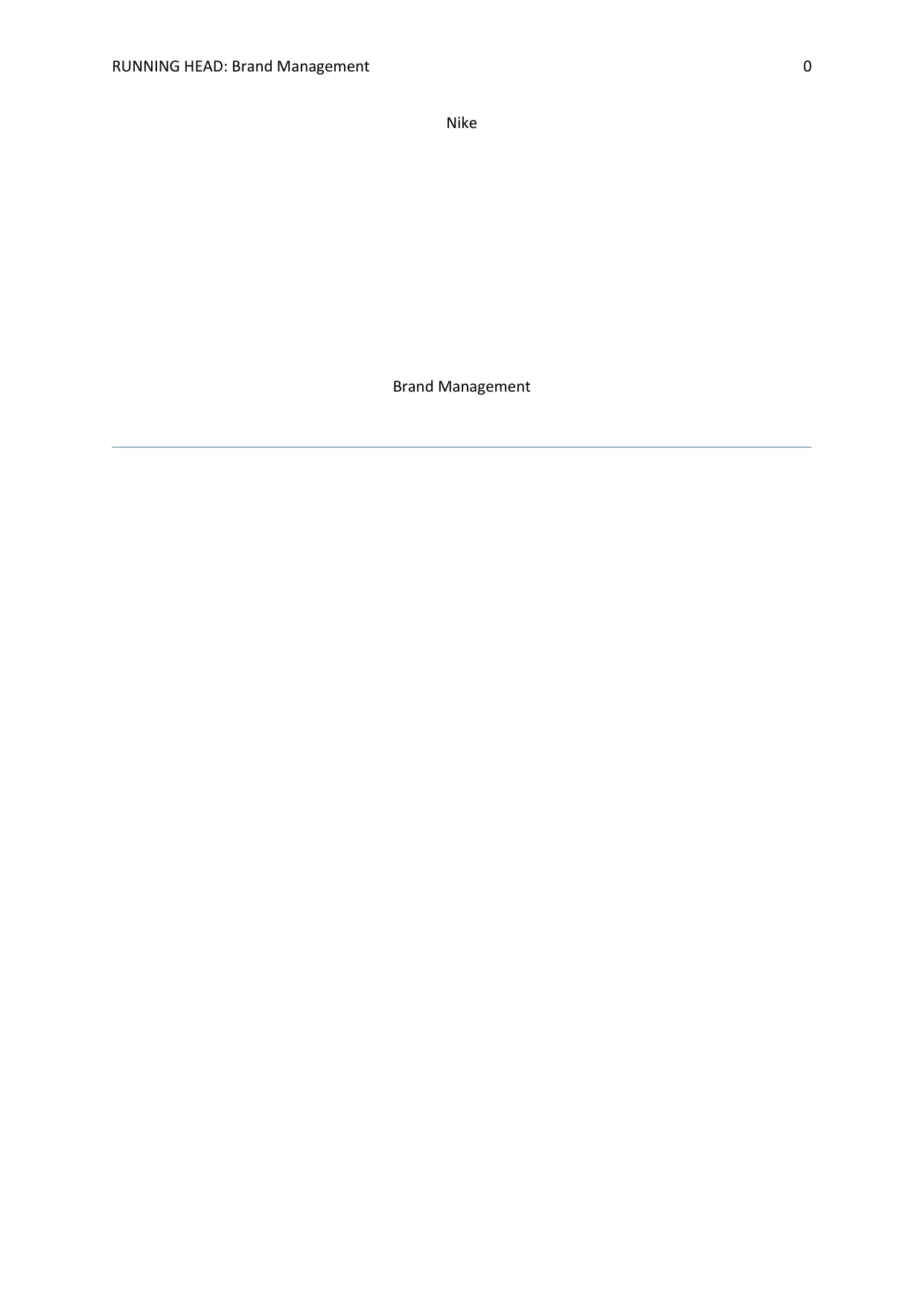
RUNNING HEAD: Brand Management 0
Nike
Brand Management
Nike
Brand Management
Paraphrase This Document
Need a fresh take? Get an instant paraphrase of this document with our AI Paraphraser

Brand Management 1
Executive summary
Nike is an international brand of US. The company believe sin sports innovation by making
products more sustainable. Its competency lies in its high performance products. This report
is divided into three segments, brand inventory, brand exploratory and brand leverage
strategy. The brand inventory includes the portfolio, positioning, mantra, elements, SWOT
analysis and strategic marketing elements. The brand exploratory comprises the consumer
consciousness, brand associations, competitive activities, consumer brand interactions and
recommended expansions in the brand equity. Finally the recommendations are also given for
the brand leverage strategy.
From the report it can be concluded that brand inventory and brand exploratory are enough to
analyse Nike as a brand. Further Nike can make use of brand leverage strategy to manage
brand in a better way.
Executive summary
Nike is an international brand of US. The company believe sin sports innovation by making
products more sustainable. Its competency lies in its high performance products. This report
is divided into three segments, brand inventory, brand exploratory and brand leverage
strategy. The brand inventory includes the portfolio, positioning, mantra, elements, SWOT
analysis and strategic marketing elements. The brand exploratory comprises the consumer
consciousness, brand associations, competitive activities, consumer brand interactions and
recommended expansions in the brand equity. Finally the recommendations are also given for
the brand leverage strategy.
From the report it can be concluded that brand inventory and brand exploratory are enough to
analyse Nike as a brand. Further Nike can make use of brand leverage strategy to manage
brand in a better way.
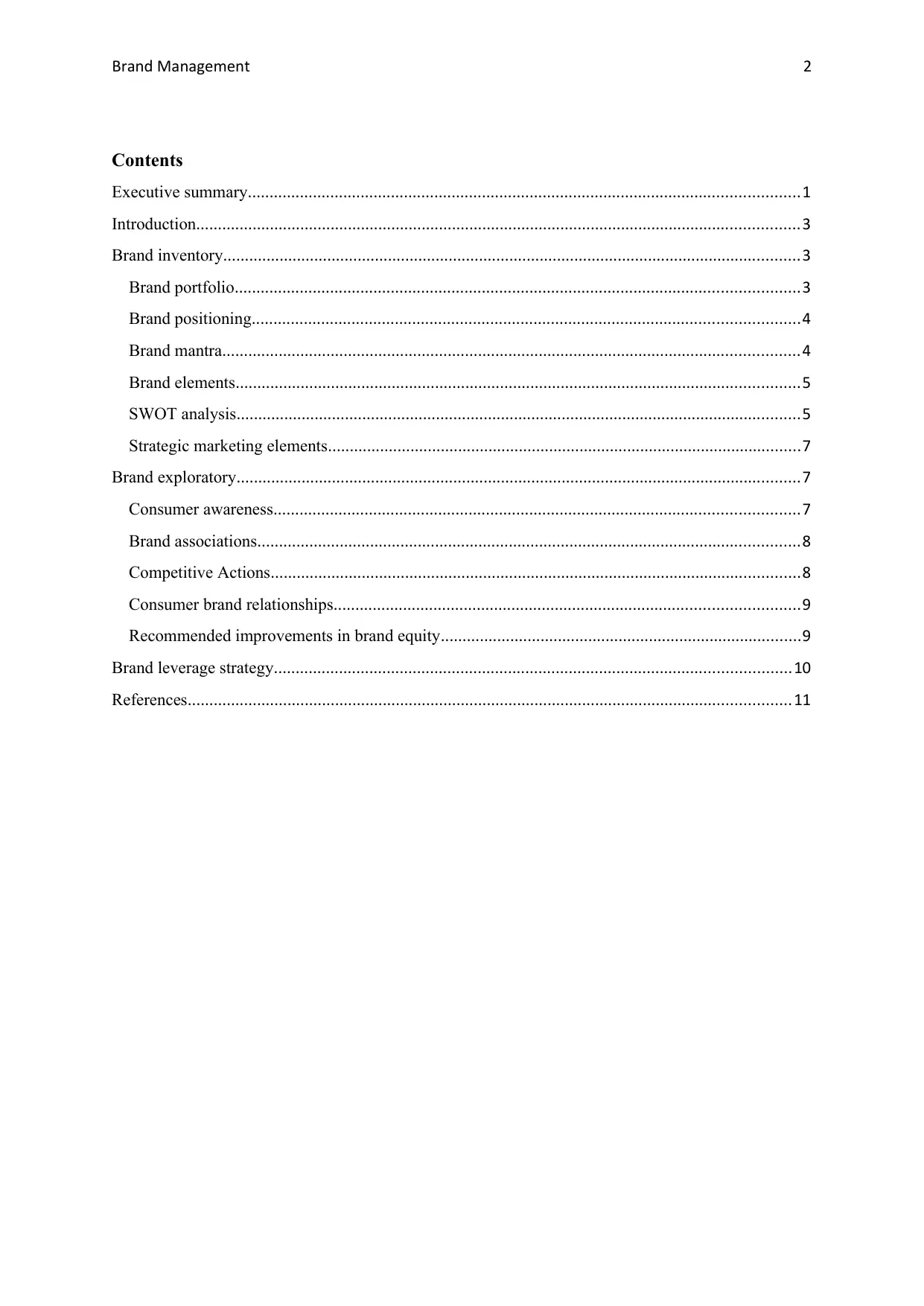
Brand Management 2
Contents
Executive summary...............................................................................................................................1
Introduction...........................................................................................................................................3
Brand inventory.....................................................................................................................................3
Brand portfolio..................................................................................................................................3
Brand positioning..............................................................................................................................4
Brand mantra.....................................................................................................................................4
Brand elements..................................................................................................................................5
SWOT analysis..................................................................................................................................5
Strategic marketing elements.............................................................................................................7
Brand exploratory..................................................................................................................................7
Consumer awareness.........................................................................................................................7
Brand associations.............................................................................................................................8
Competitive Actions..........................................................................................................................8
Consumer brand relationships...........................................................................................................9
Recommended improvements in brand equity...................................................................................9
Brand leverage strategy.......................................................................................................................10
References...........................................................................................................................................11
Contents
Executive summary...............................................................................................................................1
Introduction...........................................................................................................................................3
Brand inventory.....................................................................................................................................3
Brand portfolio..................................................................................................................................3
Brand positioning..............................................................................................................................4
Brand mantra.....................................................................................................................................4
Brand elements..................................................................................................................................5
SWOT analysis..................................................................................................................................5
Strategic marketing elements.............................................................................................................7
Brand exploratory..................................................................................................................................7
Consumer awareness.........................................................................................................................7
Brand associations.............................................................................................................................8
Competitive Actions..........................................................................................................................8
Consumer brand relationships...........................................................................................................9
Recommended improvements in brand equity...................................................................................9
Brand leverage strategy.......................................................................................................................10
References...........................................................................................................................................11
⊘ This is a preview!⊘
Do you want full access?
Subscribe today to unlock all pages.

Trusted by 1+ million students worldwide
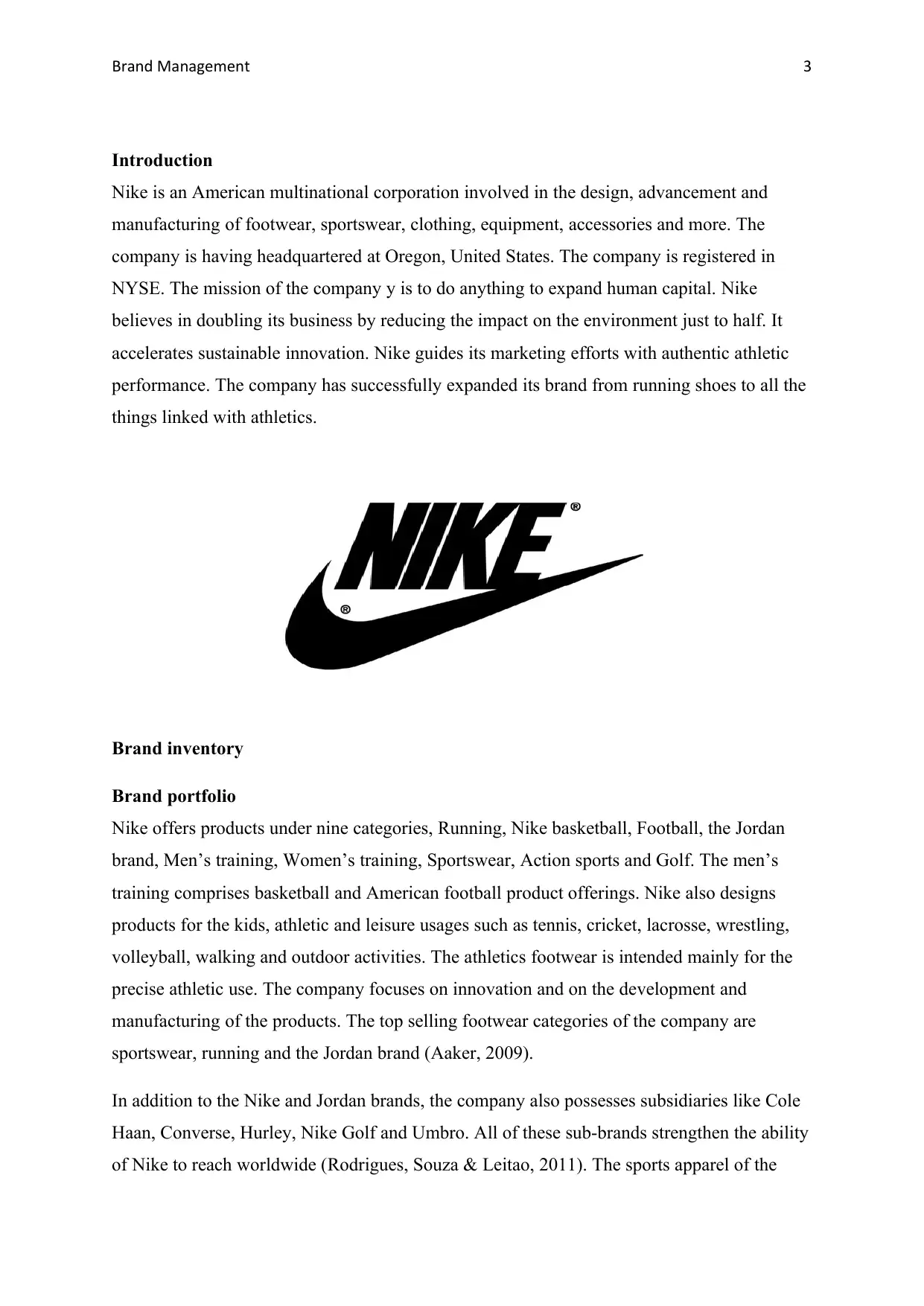
Brand Management 3
Introduction
Nike is an American multinational corporation involved in the design, advancement and
manufacturing of footwear, sportswear, clothing, equipment, accessories and more. The
company is having headquartered at Oregon, United States. The company is registered in
NYSE. The mission of the company y is to do anything to expand human capital. Nike
believes in doubling its business by reducing the impact on the environment just to half. It
accelerates sustainable innovation. Nike guides its marketing efforts with authentic athletic
performance. The company has successfully expanded its brand from running shoes to all the
things linked with athletics.
Brand inventory
Brand portfolio
Nike offers products under nine categories, Running, Nike basketball, Football, the Jordan
brand, Men’s training, Women’s training, Sportswear, Action sports and Golf. The men’s
training comprises basketball and American football product offerings. Nike also designs
products for the kids, athletic and leisure usages such as tennis, cricket, lacrosse, wrestling,
volleyball, walking and outdoor activities. The athletics footwear is intended mainly for the
precise athletic use. The company focuses on innovation and on the development and
manufacturing of the products. The top selling footwear categories of the company are
sportswear, running and the Jordan brand (Aaker, 2009).
In addition to the Nike and Jordan brands, the company also possesses subsidiaries like Cole
Haan, Converse, Hurley, Nike Golf and Umbro. All of these sub-brands strengthen the ability
of Nike to reach worldwide (Rodrigues, Souza & Leitao, 2011). The sports apparel of the
Introduction
Nike is an American multinational corporation involved in the design, advancement and
manufacturing of footwear, sportswear, clothing, equipment, accessories and more. The
company is having headquartered at Oregon, United States. The company is registered in
NYSE. The mission of the company y is to do anything to expand human capital. Nike
believes in doubling its business by reducing the impact on the environment just to half. It
accelerates sustainable innovation. Nike guides its marketing efforts with authentic athletic
performance. The company has successfully expanded its brand from running shoes to all the
things linked with athletics.
Brand inventory
Brand portfolio
Nike offers products under nine categories, Running, Nike basketball, Football, the Jordan
brand, Men’s training, Women’s training, Sportswear, Action sports and Golf. The men’s
training comprises basketball and American football product offerings. Nike also designs
products for the kids, athletic and leisure usages such as tennis, cricket, lacrosse, wrestling,
volleyball, walking and outdoor activities. The athletics footwear is intended mainly for the
precise athletic use. The company focuses on innovation and on the development and
manufacturing of the products. The top selling footwear categories of the company are
sportswear, running and the Jordan brand (Aaker, 2009).
In addition to the Nike and Jordan brands, the company also possesses subsidiaries like Cole
Haan, Converse, Hurley, Nike Golf and Umbro. All of these sub-brands strengthen the ability
of Nike to reach worldwide (Rodrigues, Souza & Leitao, 2011). The sports apparel of the
Paraphrase This Document
Need a fresh take? Get an instant paraphrase of this document with our AI Paraphraser
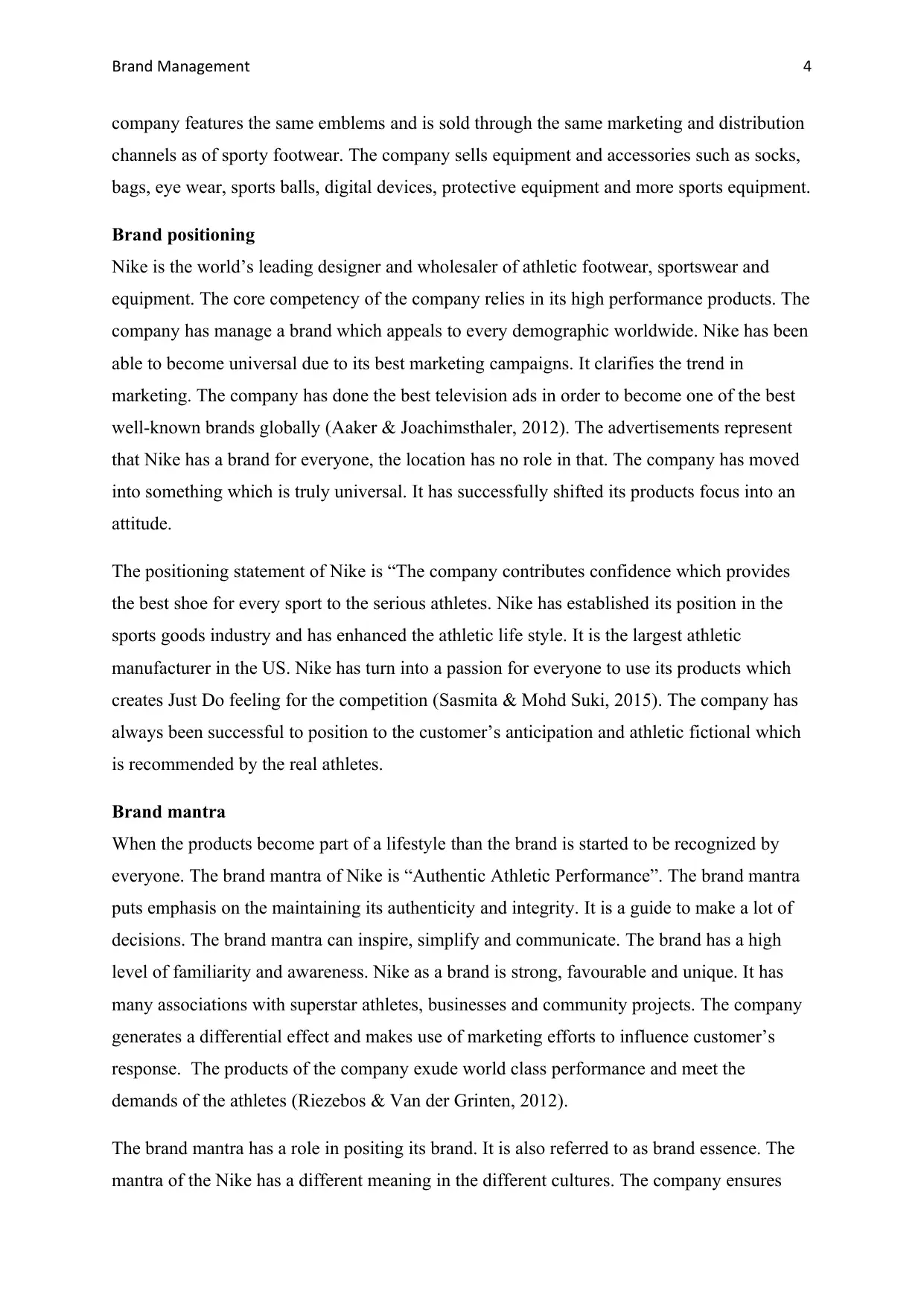
Brand Management 4
company features the same emblems and is sold through the same marketing and distribution
channels as of sporty footwear. The company sells equipment and accessories such as socks,
bags, eye wear, sports balls, digital devices, protective equipment and more sports equipment.
Brand positioning
Nike is the world’s leading designer and wholesaler of athletic footwear, sportswear and
equipment. The core competency of the company relies in its high performance products. The
company has manage a brand which appeals to every demographic worldwide. Nike has been
able to become universal due to its best marketing campaigns. It clarifies the trend in
marketing. The company has done the best television ads in order to become one of the best
well-known brands globally (Aaker & Joachimsthaler, 2012). The advertisements represent
that Nike has a brand for everyone, the location has no role in that. The company has moved
into something which is truly universal. It has successfully shifted its products focus into an
attitude.
The positioning statement of Nike is “The company contributes confidence which provides
the best shoe for every sport to the serious athletes. Nike has established its position in the
sports goods industry and has enhanced the athletic life style. It is the largest athletic
manufacturer in the US. Nike has turn into a passion for everyone to use its products which
creates Just Do feeling for the competition (Sasmita & Mohd Suki, 2015). The company has
always been successful to position to the customer’s anticipation and athletic fictional which
is recommended by the real athletes.
Brand mantra
When the products become part of a lifestyle than the brand is started to be recognized by
everyone. The brand mantra of Nike is “Authentic Athletic Performance”. The brand mantra
puts emphasis on the maintaining its authenticity and integrity. It is a guide to make a lot of
decisions. The brand mantra can inspire, simplify and communicate. The brand has a high
level of familiarity and awareness. Nike as a brand is strong, favourable and unique. It has
many associations with superstar athletes, businesses and community projects. The company
generates a differential effect and makes use of marketing efforts to influence customer’s
response. The products of the company exude world class performance and meet the
demands of the athletes (Riezebos & Van der Grinten, 2012).
The brand mantra has a role in positing its brand. It is also referred to as brand essence. The
mantra of the Nike has a different meaning in the different cultures. The company ensures
company features the same emblems and is sold through the same marketing and distribution
channels as of sporty footwear. The company sells equipment and accessories such as socks,
bags, eye wear, sports balls, digital devices, protective equipment and more sports equipment.
Brand positioning
Nike is the world’s leading designer and wholesaler of athletic footwear, sportswear and
equipment. The core competency of the company relies in its high performance products. The
company has manage a brand which appeals to every demographic worldwide. Nike has been
able to become universal due to its best marketing campaigns. It clarifies the trend in
marketing. The company has done the best television ads in order to become one of the best
well-known brands globally (Aaker & Joachimsthaler, 2012). The advertisements represent
that Nike has a brand for everyone, the location has no role in that. The company has moved
into something which is truly universal. It has successfully shifted its products focus into an
attitude.
The positioning statement of Nike is “The company contributes confidence which provides
the best shoe for every sport to the serious athletes. Nike has established its position in the
sports goods industry and has enhanced the athletic life style. It is the largest athletic
manufacturer in the US. Nike has turn into a passion for everyone to use its products which
creates Just Do feeling for the competition (Sasmita & Mohd Suki, 2015). The company has
always been successful to position to the customer’s anticipation and athletic fictional which
is recommended by the real athletes.
Brand mantra
When the products become part of a lifestyle than the brand is started to be recognized by
everyone. The brand mantra of Nike is “Authentic Athletic Performance”. The brand mantra
puts emphasis on the maintaining its authenticity and integrity. It is a guide to make a lot of
decisions. The brand mantra can inspire, simplify and communicate. The brand has a high
level of familiarity and awareness. Nike as a brand is strong, favourable and unique. It has
many associations with superstar athletes, businesses and community projects. The company
generates a differential effect and makes use of marketing efforts to influence customer’s
response. The products of the company exude world class performance and meet the
demands of the athletes (Riezebos & Van der Grinten, 2012).
The brand mantra has a role in positing its brand. It is also referred to as brand essence. The
mantra of the Nike has a different meaning in the different cultures. The company ensures
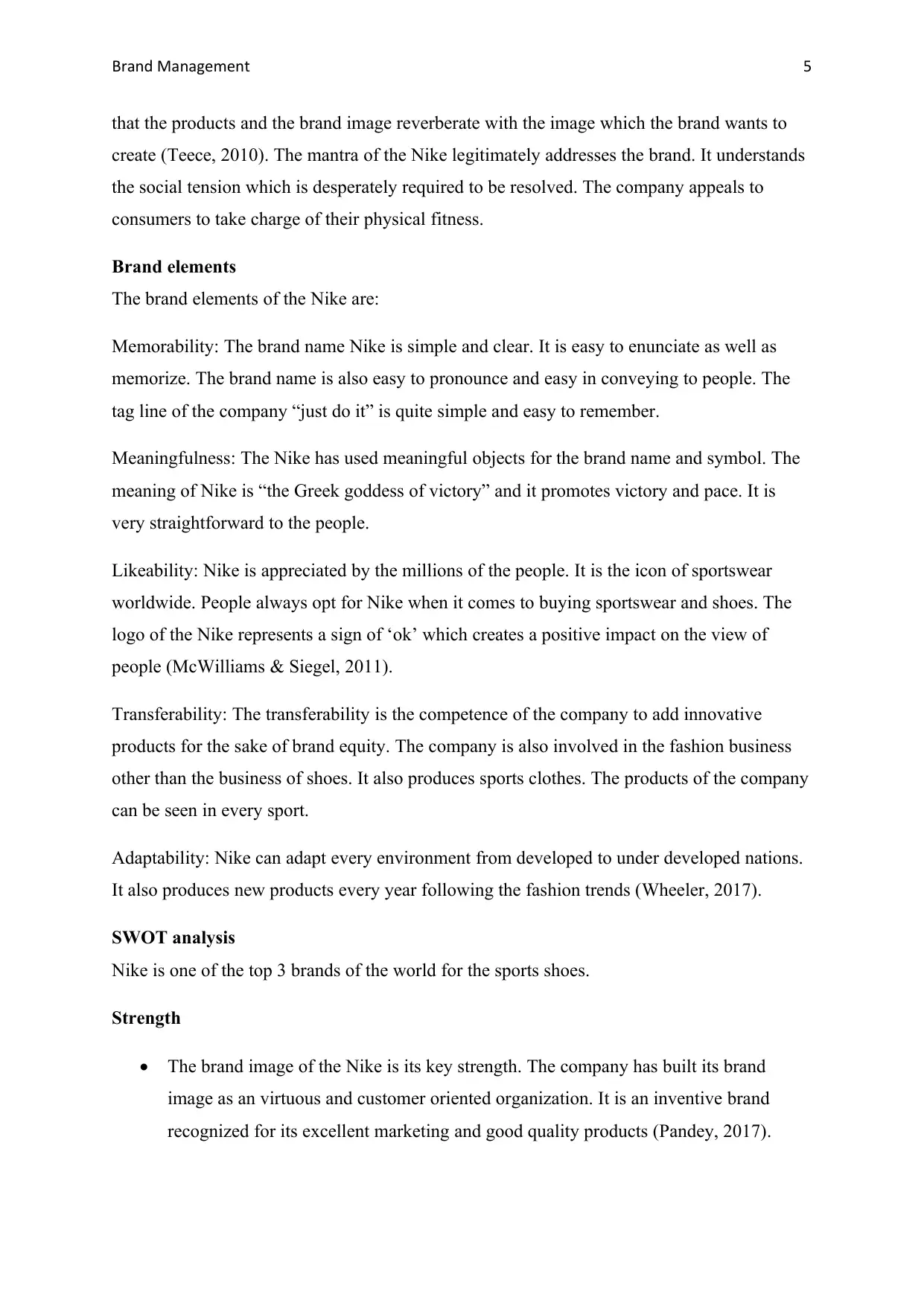
Brand Management 5
that the products and the brand image reverberate with the image which the brand wants to
create (Teece, 2010). The mantra of the Nike legitimately addresses the brand. It understands
the social tension which is desperately required to be resolved. The company appeals to
consumers to take charge of their physical fitness.
Brand elements
The brand elements of the Nike are:
Memorability: The brand name Nike is simple and clear. It is easy to enunciate as well as
memorize. The brand name is also easy to pronounce and easy in conveying to people. The
tag line of the company “just do it” is quite simple and easy to remember.
Meaningfulness: The Nike has used meaningful objects for the brand name and symbol. The
meaning of Nike is “the Greek goddess of victory” and it promotes victory and pace. It is
very straightforward to the people.
Likeability: Nike is appreciated by the millions of the people. It is the icon of sportswear
worldwide. People always opt for Nike when it comes to buying sportswear and shoes. The
logo of the Nike represents a sign of ‘ok’ which creates a positive impact on the view of
people (McWilliams & Siegel, 2011).
Transferability: The transferability is the competence of the company to add innovative
products for the sake of brand equity. The company is also involved in the fashion business
other than the business of shoes. It also produces sports clothes. The products of the company
can be seen in every sport.
Adaptability: Nike can adapt every environment from developed to under developed nations.
It also produces new products every year following the fashion trends (Wheeler, 2017).
SWOT analysis
Nike is one of the top 3 brands of the world for the sports shoes.
Strength
The brand image of the Nike is its key strength. The company has built its brand
image as an virtuous and customer oriented organization. It is an inventive brand
recognized for its excellent marketing and good quality products (Pandey, 2017).
that the products and the brand image reverberate with the image which the brand wants to
create (Teece, 2010). The mantra of the Nike legitimately addresses the brand. It understands
the social tension which is desperately required to be resolved. The company appeals to
consumers to take charge of their physical fitness.
Brand elements
The brand elements of the Nike are:
Memorability: The brand name Nike is simple and clear. It is easy to enunciate as well as
memorize. The brand name is also easy to pronounce and easy in conveying to people. The
tag line of the company “just do it” is quite simple and easy to remember.
Meaningfulness: The Nike has used meaningful objects for the brand name and symbol. The
meaning of Nike is “the Greek goddess of victory” and it promotes victory and pace. It is
very straightforward to the people.
Likeability: Nike is appreciated by the millions of the people. It is the icon of sportswear
worldwide. People always opt for Nike when it comes to buying sportswear and shoes. The
logo of the Nike represents a sign of ‘ok’ which creates a positive impact on the view of
people (McWilliams & Siegel, 2011).
Transferability: The transferability is the competence of the company to add innovative
products for the sake of brand equity. The company is also involved in the fashion business
other than the business of shoes. It also produces sports clothes. The products of the company
can be seen in every sport.
Adaptability: Nike can adapt every environment from developed to under developed nations.
It also produces new products every year following the fashion trends (Wheeler, 2017).
SWOT analysis
Nike is one of the top 3 brands of the world for the sports shoes.
Strength
The brand image of the Nike is its key strength. The company has built its brand
image as an virtuous and customer oriented organization. It is an inventive brand
recognized for its excellent marketing and good quality products (Pandey, 2017).
⊘ This is a preview!⊘
Do you want full access?
Subscribe today to unlock all pages.

Trusted by 1+ million students worldwide
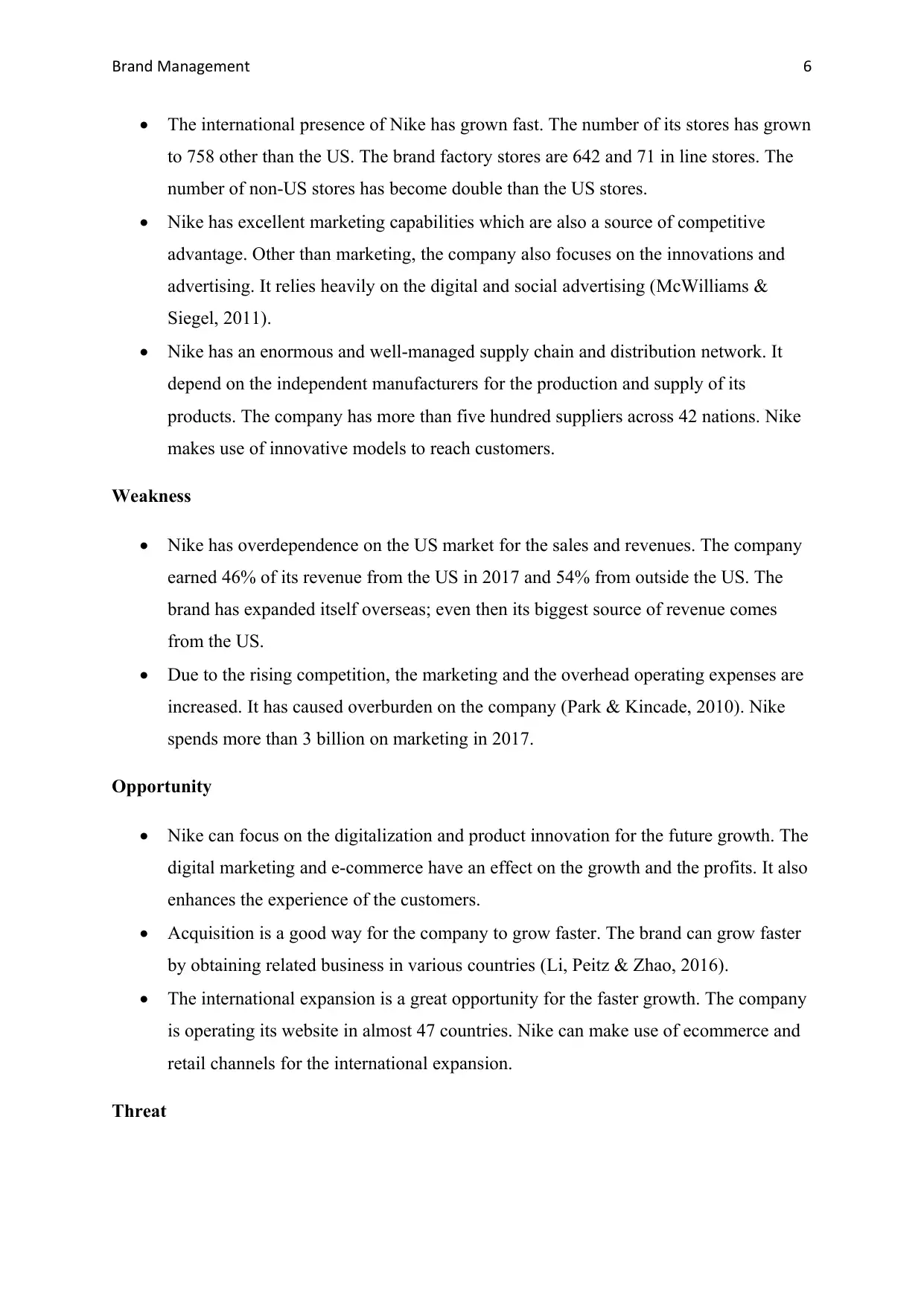
Brand Management 6
The international presence of Nike has grown fast. The number of its stores has grown
to 758 other than the US. The brand factory stores are 642 and 71 in line stores. The
number of non-US stores has become double than the US stores.
Nike has excellent marketing capabilities which are also a source of competitive
advantage. Other than marketing, the company also focuses on the innovations and
advertising. It relies heavily on the digital and social advertising (McWilliams &
Siegel, 2011).
Nike has an enormous and well-managed supply chain and distribution network. It
depend on the independent manufacturers for the production and supply of its
products. The company has more than five hundred suppliers across 42 nations. Nike
makes use of innovative models to reach customers.
Weakness
Nike has overdependence on the US market for the sales and revenues. The company
earned 46% of its revenue from the US in 2017 and 54% from outside the US. The
brand has expanded itself overseas; even then its biggest source of revenue comes
from the US.
Due to the rising competition, the marketing and the overhead operating expenses are
increased. It has caused overburden on the company (Park & Kincade, 2010). Nike
spends more than 3 billion on marketing in 2017.
Opportunity
Nike can focus on the digitalization and product innovation for the future growth. The
digital marketing and e-commerce have an effect on the growth and the profits. It also
enhances the experience of the customers.
Acquisition is a good way for the company to grow faster. The brand can grow faster
by obtaining related business in various countries (Li, Peitz & Zhao, 2016).
The international expansion is a great opportunity for the faster growth. The company
is operating its website in almost 47 countries. Nike can make use of ecommerce and
retail channels for the international expansion.
Threat
The international presence of Nike has grown fast. The number of its stores has grown
to 758 other than the US. The brand factory stores are 642 and 71 in line stores. The
number of non-US stores has become double than the US stores.
Nike has excellent marketing capabilities which are also a source of competitive
advantage. Other than marketing, the company also focuses on the innovations and
advertising. It relies heavily on the digital and social advertising (McWilliams &
Siegel, 2011).
Nike has an enormous and well-managed supply chain and distribution network. It
depend on the independent manufacturers for the production and supply of its
products. The company has more than five hundred suppliers across 42 nations. Nike
makes use of innovative models to reach customers.
Weakness
Nike has overdependence on the US market for the sales and revenues. The company
earned 46% of its revenue from the US in 2017 and 54% from outside the US. The
brand has expanded itself overseas; even then its biggest source of revenue comes
from the US.
Due to the rising competition, the marketing and the overhead operating expenses are
increased. It has caused overburden on the company (Park & Kincade, 2010). Nike
spends more than 3 billion on marketing in 2017.
Opportunity
Nike can focus on the digitalization and product innovation for the future growth. The
digital marketing and e-commerce have an effect on the growth and the profits. It also
enhances the experience of the customers.
Acquisition is a good way for the company to grow faster. The brand can grow faster
by obtaining related business in various countries (Li, Peitz & Zhao, 2016).
The international expansion is a great opportunity for the faster growth. The company
is operating its website in almost 47 countries. Nike can make use of ecommerce and
retail channels for the international expansion.
Threat
Paraphrase This Document
Need a fresh take? Get an instant paraphrase of this document with our AI Paraphraser
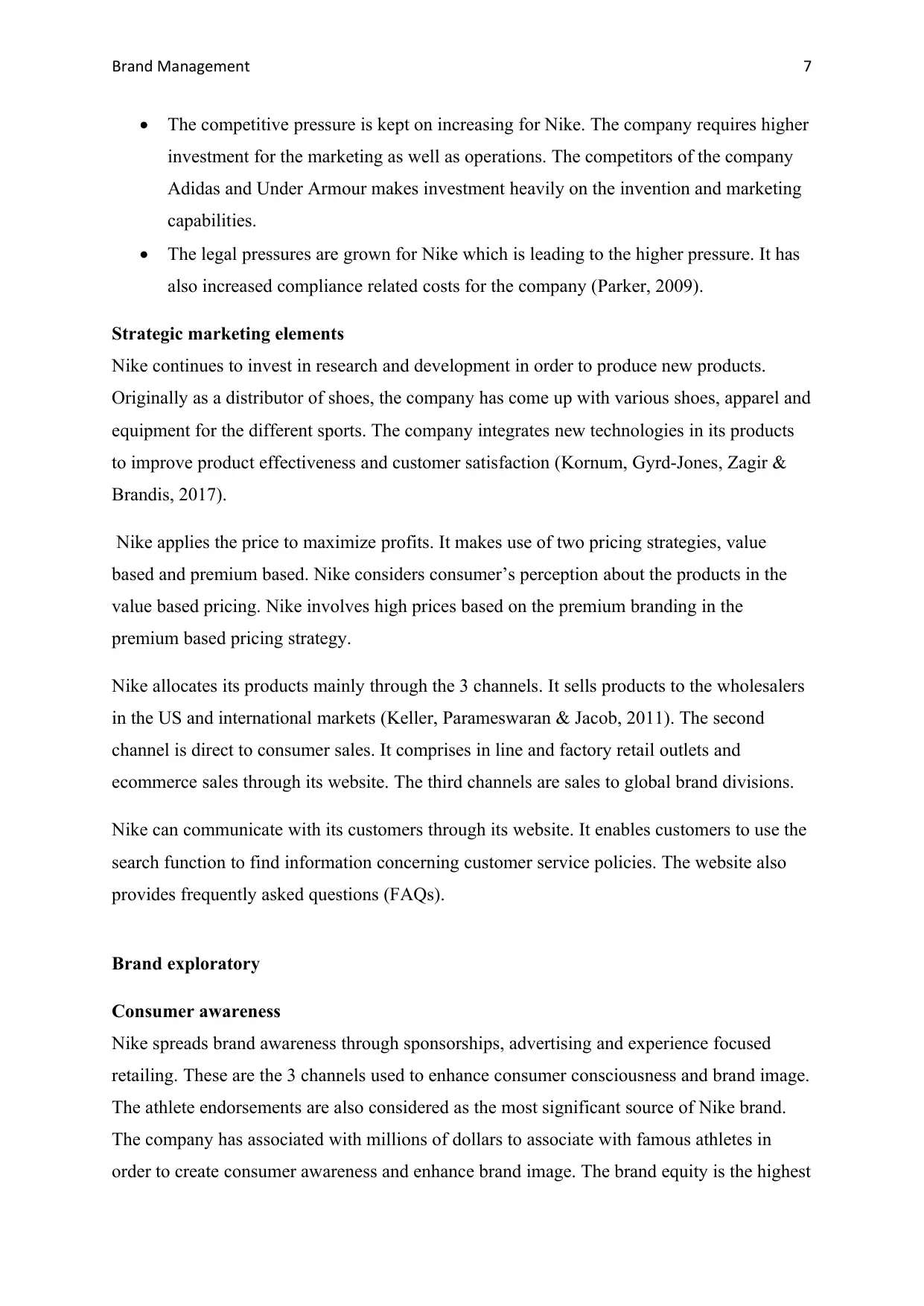
Brand Management 7
The competitive pressure is kept on increasing for Nike. The company requires higher
investment for the marketing as well as operations. The competitors of the company
Adidas and Under Armour makes investment heavily on the invention and marketing
capabilities.
The legal pressures are grown for Nike which is leading to the higher pressure. It has
also increased compliance related costs for the company (Parker, 2009).
Strategic marketing elements
Nike continues to invest in research and development in order to produce new products.
Originally as a distributor of shoes, the company has come up with various shoes, apparel and
equipment for the different sports. The company integrates new technologies in its products
to improve product effectiveness and customer satisfaction (Kornum, Gyrd-Jones, Zagir &
Brandis, 2017).
Nike applies the price to maximize profits. It makes use of two pricing strategies, value
based and premium based. Nike considers consumer’s perception about the products in the
value based pricing. Nike involves high prices based on the premium branding in the
premium based pricing strategy.
Nike allocates its products mainly through the 3 channels. It sells products to the wholesalers
in the US and international markets (Keller, Parameswaran & Jacob, 2011). The second
channel is direct to consumer sales. It comprises in line and factory retail outlets and
ecommerce sales through its website. The third channels are sales to global brand divisions.
Nike can communicate with its customers through its website. It enables customers to use the
search function to find information concerning customer service policies. The website also
provides frequently asked questions (FAQs).
Brand exploratory
Consumer awareness
Nike spreads brand awareness through sponsorships, advertising and experience focused
retailing. These are the 3 channels used to enhance consumer consciousness and brand image.
The athlete endorsements are also considered as the most significant source of Nike brand.
The company has associated with millions of dollars to associate with famous athletes in
order to create consumer awareness and enhance brand image. The brand equity is the highest
The competitive pressure is kept on increasing for Nike. The company requires higher
investment for the marketing as well as operations. The competitors of the company
Adidas and Under Armour makes investment heavily on the invention and marketing
capabilities.
The legal pressures are grown for Nike which is leading to the higher pressure. It has
also increased compliance related costs for the company (Parker, 2009).
Strategic marketing elements
Nike continues to invest in research and development in order to produce new products.
Originally as a distributor of shoes, the company has come up with various shoes, apparel and
equipment for the different sports. The company integrates new technologies in its products
to improve product effectiveness and customer satisfaction (Kornum, Gyrd-Jones, Zagir &
Brandis, 2017).
Nike applies the price to maximize profits. It makes use of two pricing strategies, value
based and premium based. Nike considers consumer’s perception about the products in the
value based pricing. Nike involves high prices based on the premium branding in the
premium based pricing strategy.
Nike allocates its products mainly through the 3 channels. It sells products to the wholesalers
in the US and international markets (Keller, Parameswaran & Jacob, 2011). The second
channel is direct to consumer sales. It comprises in line and factory retail outlets and
ecommerce sales through its website. The third channels are sales to global brand divisions.
Nike can communicate with its customers through its website. It enables customers to use the
search function to find information concerning customer service policies. The website also
provides frequently asked questions (FAQs).
Brand exploratory
Consumer awareness
Nike spreads brand awareness through sponsorships, advertising and experience focused
retailing. These are the 3 channels used to enhance consumer consciousness and brand image.
The athlete endorsements are also considered as the most significant source of Nike brand.
The company has associated with millions of dollars to associate with famous athletes in
order to create consumer awareness and enhance brand image. The brand equity is the highest
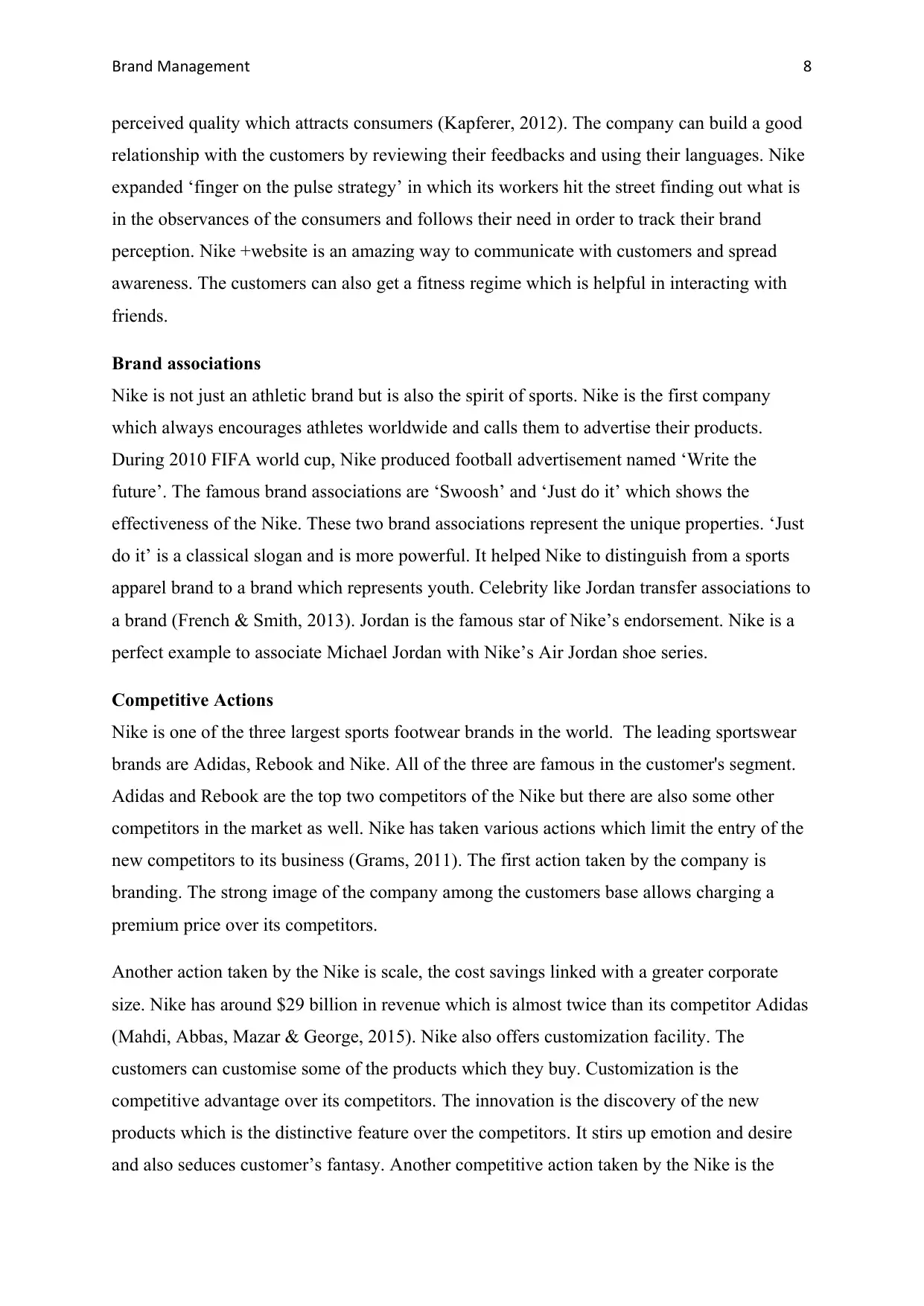
Brand Management 8
perceived quality which attracts consumers (Kapferer, 2012). The company can build a good
relationship with the customers by reviewing their feedbacks and using their languages. Nike
expanded ‘finger on the pulse strategy’ in which its workers hit the street finding out what is
in the observances of the consumers and follows their need in order to track their brand
perception. Nike +website is an amazing way to communicate with customers and spread
awareness. The customers can also get a fitness regime which is helpful in interacting with
friends.
Brand associations
Nike is not just an athletic brand but is also the spirit of sports. Nike is the first company
which always encourages athletes worldwide and calls them to advertise their products.
During 2010 FIFA world cup, Nike produced football advertisement named ‘Write the
future’. The famous brand associations are ‘Swoosh’ and ‘Just do it’ which shows the
effectiveness of the Nike. These two brand associations represent the unique properties. ‘Just
do it’ is a classical slogan and is more powerful. It helped Nike to distinguish from a sports
apparel brand to a brand which represents youth. Celebrity like Jordan transfer associations to
a brand (French & Smith, 2013). Jordan is the famous star of Nike’s endorsement. Nike is a
perfect example to associate Michael Jordan with Nike’s Air Jordan shoe series.
Competitive Actions
Nike is one of the three largest sports footwear brands in the world. The leading sportswear
brands are Adidas, Rebook and Nike. All of the three are famous in the customer's segment.
Adidas and Rebook are the top two competitors of the Nike but there are also some other
competitors in the market as well. Nike has taken various actions which limit the entry of the
new competitors to its business (Grams, 2011). The first action taken by the company is
branding. The strong image of the company among the customers base allows charging a
premium price over its competitors.
Another action taken by the Nike is scale, the cost savings linked with a greater corporate
size. Nike has around $29 billion in revenue which is almost twice than its competitor Adidas
(Mahdi, Abbas, Mazar & George, 2015). Nike also offers customization facility. The
customers can customise some of the products which they buy. Customization is the
competitive advantage over its competitors. The innovation is the discovery of the new
products which is the distinctive feature over the competitors. It stirs up emotion and desire
and also seduces customer’s fantasy. Another competitive action taken by the Nike is the
perceived quality which attracts consumers (Kapferer, 2012). The company can build a good
relationship with the customers by reviewing their feedbacks and using their languages. Nike
expanded ‘finger on the pulse strategy’ in which its workers hit the street finding out what is
in the observances of the consumers and follows their need in order to track their brand
perception. Nike +website is an amazing way to communicate with customers and spread
awareness. The customers can also get a fitness regime which is helpful in interacting with
friends.
Brand associations
Nike is not just an athletic brand but is also the spirit of sports. Nike is the first company
which always encourages athletes worldwide and calls them to advertise their products.
During 2010 FIFA world cup, Nike produced football advertisement named ‘Write the
future’. The famous brand associations are ‘Swoosh’ and ‘Just do it’ which shows the
effectiveness of the Nike. These two brand associations represent the unique properties. ‘Just
do it’ is a classical slogan and is more powerful. It helped Nike to distinguish from a sports
apparel brand to a brand which represents youth. Celebrity like Jordan transfer associations to
a brand (French & Smith, 2013). Jordan is the famous star of Nike’s endorsement. Nike is a
perfect example to associate Michael Jordan with Nike’s Air Jordan shoe series.
Competitive Actions
Nike is one of the three largest sports footwear brands in the world. The leading sportswear
brands are Adidas, Rebook and Nike. All of the three are famous in the customer's segment.
Adidas and Rebook are the top two competitors of the Nike but there are also some other
competitors in the market as well. Nike has taken various actions which limit the entry of the
new competitors to its business (Grams, 2011). The first action taken by the company is
branding. The strong image of the company among the customers base allows charging a
premium price over its competitors.
Another action taken by the Nike is scale, the cost savings linked with a greater corporate
size. Nike has around $29 billion in revenue which is almost twice than its competitor Adidas
(Mahdi, Abbas, Mazar & George, 2015). Nike also offers customization facility. The
customers can customise some of the products which they buy. Customization is the
competitive advantage over its competitors. The innovation is the discovery of the new
products which is the distinctive feature over the competitors. It stirs up emotion and desire
and also seduces customer’s fantasy. Another competitive action taken by the Nike is the
⊘ This is a preview!⊘
Do you want full access?
Subscribe today to unlock all pages.

Trusted by 1+ million students worldwide
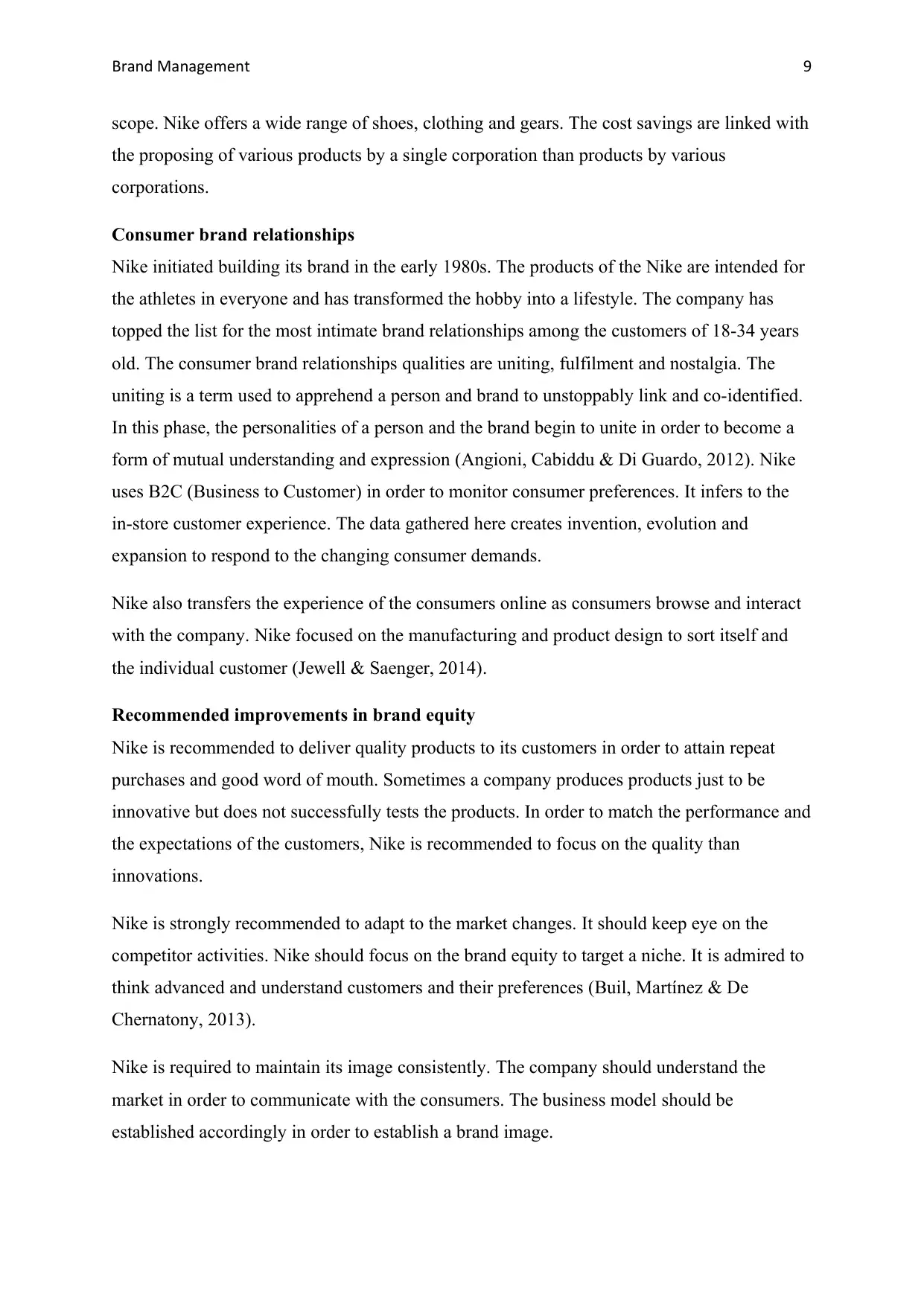
Brand Management 9
scope. Nike offers a wide range of shoes, clothing and gears. The cost savings are linked with
the proposing of various products by a single corporation than products by various
corporations.
Consumer brand relationships
Nike initiated building its brand in the early 1980s. The products of the Nike are intended for
the athletes in everyone and has transformed the hobby into a lifestyle. The company has
topped the list for the most intimate brand relationships among the customers of 18-34 years
old. The consumer brand relationships qualities are uniting, fulfilment and nostalgia. The
uniting is a term used to apprehend a person and brand to unstoppably link and co-identified.
In this phase, the personalities of a person and the brand begin to unite in order to become a
form of mutual understanding and expression (Angioni, Cabiddu & Di Guardo, 2012). Nike
uses B2C (Business to Customer) in order to monitor consumer preferences. It infers to the
in-store customer experience. The data gathered here creates invention, evolution and
expansion to respond to the changing consumer demands.
Nike also transfers the experience of the consumers online as consumers browse and interact
with the company. Nike focused on the manufacturing and product design to sort itself and
the individual customer (Jewell & Saenger, 2014).
Recommended improvements in brand equity
Nike is recommended to deliver quality products to its customers in order to attain repeat
purchases and good word of mouth. Sometimes a company produces products just to be
innovative but does not successfully tests the products. In order to match the performance and
the expectations of the customers, Nike is recommended to focus on the quality than
innovations.
Nike is strongly recommended to adapt to the market changes. It should keep eye on the
competitor activities. Nike should focus on the brand equity to target a niche. It is admired to
think advanced and understand customers and their preferences (Buil, Martínez & De
Chernatony, 2013).
Nike is required to maintain its image consistently. The company should understand the
market in order to communicate with the consumers. The business model should be
established accordingly in order to establish a brand image.
scope. Nike offers a wide range of shoes, clothing and gears. The cost savings are linked with
the proposing of various products by a single corporation than products by various
corporations.
Consumer brand relationships
Nike initiated building its brand in the early 1980s. The products of the Nike are intended for
the athletes in everyone and has transformed the hobby into a lifestyle. The company has
topped the list for the most intimate brand relationships among the customers of 18-34 years
old. The consumer brand relationships qualities are uniting, fulfilment and nostalgia. The
uniting is a term used to apprehend a person and brand to unstoppably link and co-identified.
In this phase, the personalities of a person and the brand begin to unite in order to become a
form of mutual understanding and expression (Angioni, Cabiddu & Di Guardo, 2012). Nike
uses B2C (Business to Customer) in order to monitor consumer preferences. It infers to the
in-store customer experience. The data gathered here creates invention, evolution and
expansion to respond to the changing consumer demands.
Nike also transfers the experience of the consumers online as consumers browse and interact
with the company. Nike focused on the manufacturing and product design to sort itself and
the individual customer (Jewell & Saenger, 2014).
Recommended improvements in brand equity
Nike is recommended to deliver quality products to its customers in order to attain repeat
purchases and good word of mouth. Sometimes a company produces products just to be
innovative but does not successfully tests the products. In order to match the performance and
the expectations of the customers, Nike is recommended to focus on the quality than
innovations.
Nike is strongly recommended to adapt to the market changes. It should keep eye on the
competitor activities. Nike should focus on the brand equity to target a niche. It is admired to
think advanced and understand customers and their preferences (Buil, Martínez & De
Chernatony, 2013).
Nike is required to maintain its image consistently. The company should understand the
market in order to communicate with the consumers. The business model should be
established accordingly in order to establish a brand image.
Paraphrase This Document
Need a fresh take? Get an instant paraphrase of this document with our AI Paraphraser
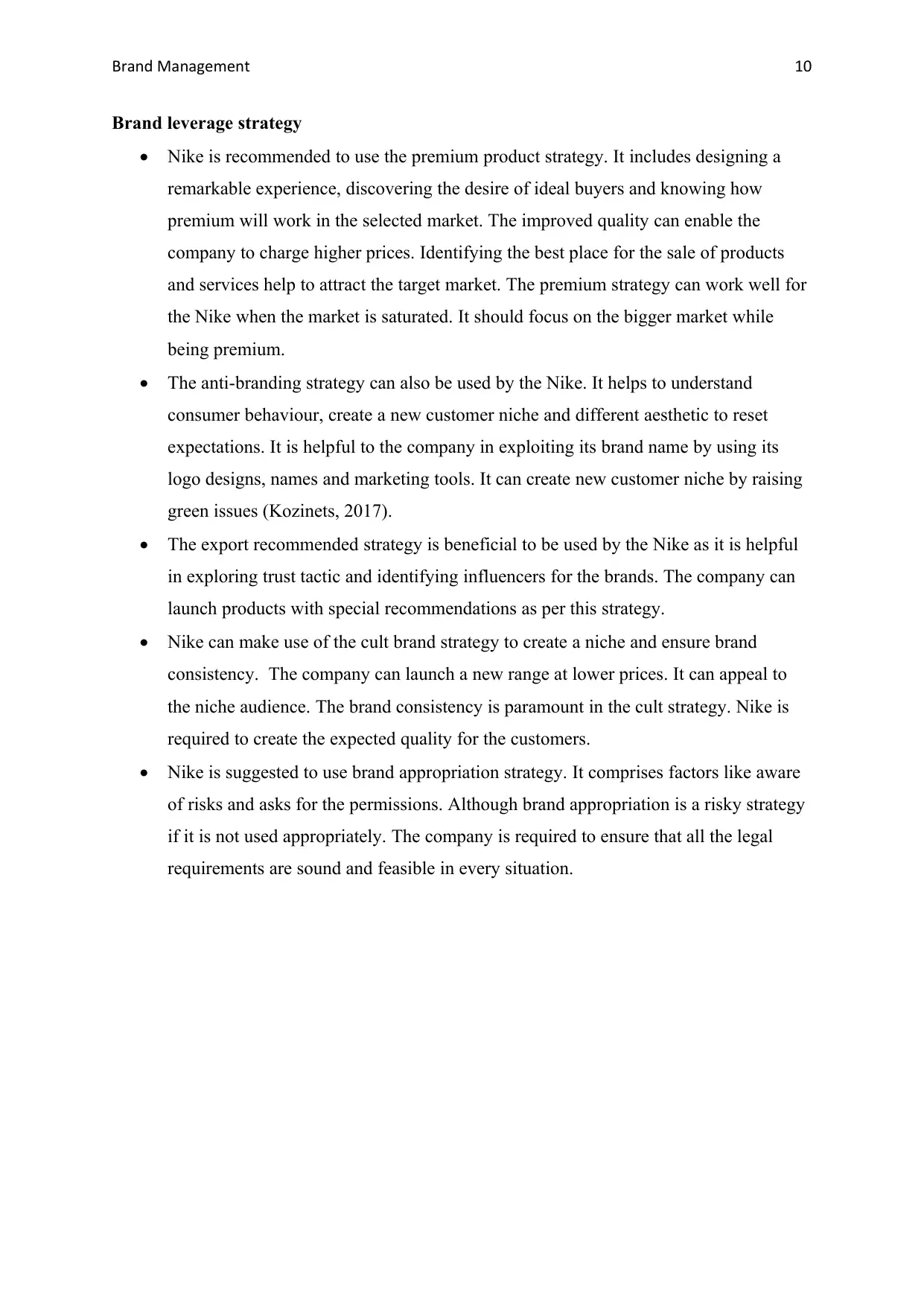
Brand Management 10
Brand leverage strategy
Nike is recommended to use the premium product strategy. It includes designing a
remarkable experience, discovering the desire of ideal buyers and knowing how
premium will work in the selected market. The improved quality can enable the
company to charge higher prices. Identifying the best place for the sale of products
and services help to attract the target market. The premium strategy can work well for
the Nike when the market is saturated. It should focus on the bigger market while
being premium.
The anti-branding strategy can also be used by the Nike. It helps to understand
consumer behaviour, create a new customer niche and different aesthetic to reset
expectations. It is helpful to the company in exploiting its brand name by using its
logo designs, names and marketing tools. It can create new customer niche by raising
green issues (Kozinets, 2017).
The export recommended strategy is beneficial to be used by the Nike as it is helpful
in exploring trust tactic and identifying influencers for the brands. The company can
launch products with special recommendations as per this strategy.
Nike can make use of the cult brand strategy to create a niche and ensure brand
consistency. The company can launch a new range at lower prices. It can appeal to
the niche audience. The brand consistency is paramount in the cult strategy. Nike is
required to create the expected quality for the customers.
Nike is suggested to use brand appropriation strategy. It comprises factors like aware
of risks and asks for the permissions. Although brand appropriation is a risky strategy
if it is not used appropriately. The company is required to ensure that all the legal
requirements are sound and feasible in every situation.
Brand leverage strategy
Nike is recommended to use the premium product strategy. It includes designing a
remarkable experience, discovering the desire of ideal buyers and knowing how
premium will work in the selected market. The improved quality can enable the
company to charge higher prices. Identifying the best place for the sale of products
and services help to attract the target market. The premium strategy can work well for
the Nike when the market is saturated. It should focus on the bigger market while
being premium.
The anti-branding strategy can also be used by the Nike. It helps to understand
consumer behaviour, create a new customer niche and different aesthetic to reset
expectations. It is helpful to the company in exploiting its brand name by using its
logo designs, names and marketing tools. It can create new customer niche by raising
green issues (Kozinets, 2017).
The export recommended strategy is beneficial to be used by the Nike as it is helpful
in exploring trust tactic and identifying influencers for the brands. The company can
launch products with special recommendations as per this strategy.
Nike can make use of the cult brand strategy to create a niche and ensure brand
consistency. The company can launch a new range at lower prices. It can appeal to
the niche audience. The brand consistency is paramount in the cult strategy. Nike is
required to create the expected quality for the customers.
Nike is suggested to use brand appropriation strategy. It comprises factors like aware
of risks and asks for the permissions. Although brand appropriation is a risky strategy
if it is not used appropriately. The company is required to ensure that all the legal
requirements are sound and feasible in every situation.
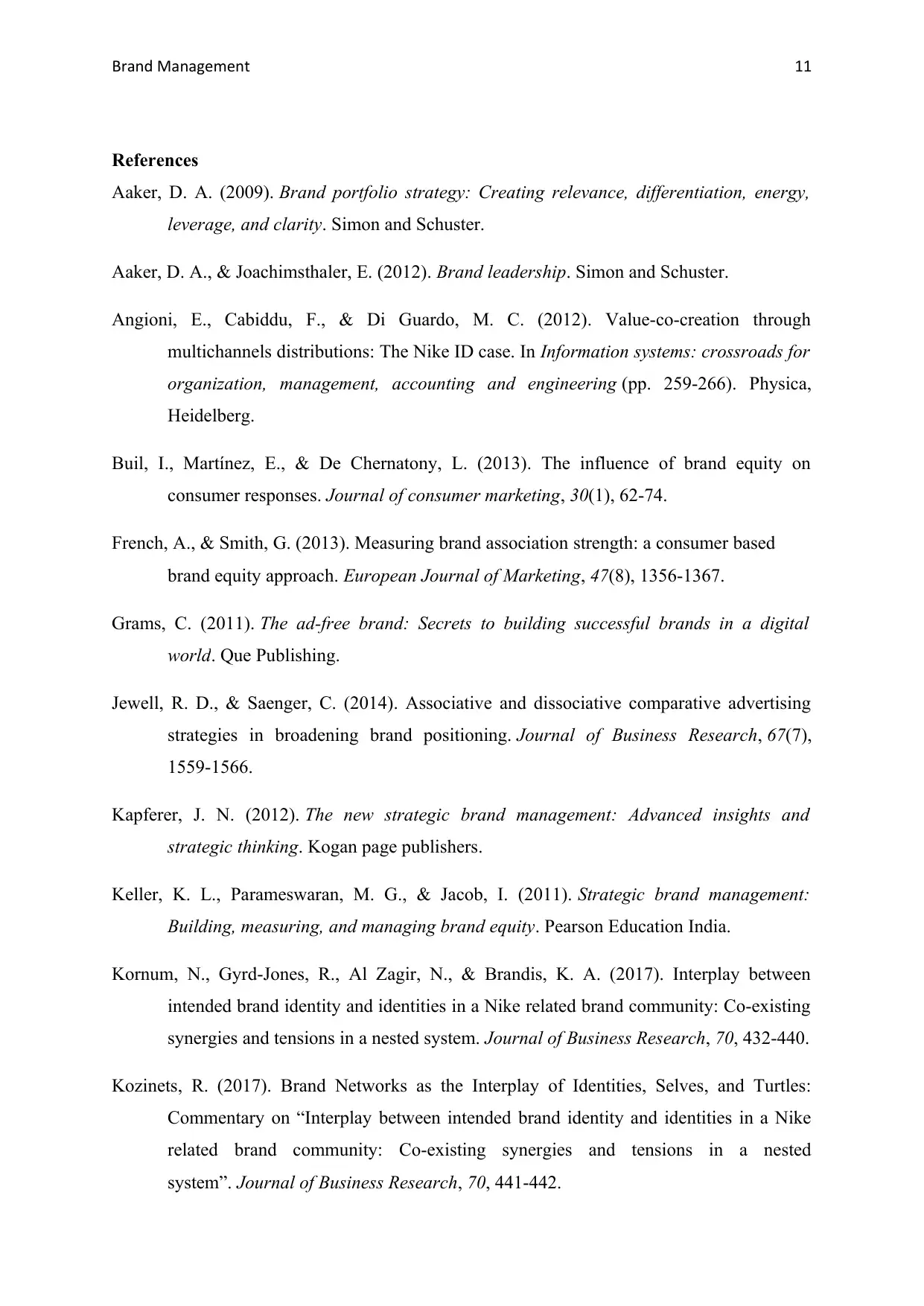
Brand Management 11
References
Aaker, D. A. (2009). Brand portfolio strategy: Creating relevance, differentiation, energy,
leverage, and clarity. Simon and Schuster.
Aaker, D. A., & Joachimsthaler, E. (2012). Brand leadership. Simon and Schuster.
Angioni, E., Cabiddu, F., & Di Guardo, M. C. (2012). Value-co-creation through
multichannels distributions: The Nike ID case. In Information systems: crossroads for
organization, management, accounting and engineering (pp. 259-266). Physica,
Heidelberg.
Buil, I., Martínez, E., & De Chernatony, L. (2013). The influence of brand equity on
consumer responses. Journal of consumer marketing, 30(1), 62-74.
French, A., & Smith, G. (2013). Measuring brand association strength: a consumer based
brand equity approach. European Journal of Marketing, 47(8), 1356-1367.
Grams, C. (2011). The ad-free brand: Secrets to building successful brands in a digital
world. Que Publishing.
Jewell, R. D., & Saenger, C. (2014). Associative and dissociative comparative advertising
strategies in broadening brand positioning. Journal of Business Research, 67(7),
1559-1566.
Kapferer, J. N. (2012). The new strategic brand management: Advanced insights and
strategic thinking. Kogan page publishers.
Keller, K. L., Parameswaran, M. G., & Jacob, I. (2011). Strategic brand management:
Building, measuring, and managing brand equity. Pearson Education India.
Kornum, N., Gyrd-Jones, R., Al Zagir, N., & Brandis, K. A. (2017). Interplay between
intended brand identity and identities in a Nike related brand community: Co-existing
synergies and tensions in a nested system. Journal of Business Research, 70, 432-440.
Kozinets, R. (2017). Brand Networks as the Interplay of Identities, Selves, and Turtles:
Commentary on “Interplay between intended brand identity and identities in a Nike
related brand community: Co-existing synergies and tensions in a nested
system”. Journal of Business Research, 70, 441-442.
References
Aaker, D. A. (2009). Brand portfolio strategy: Creating relevance, differentiation, energy,
leverage, and clarity. Simon and Schuster.
Aaker, D. A., & Joachimsthaler, E. (2012). Brand leadership. Simon and Schuster.
Angioni, E., Cabiddu, F., & Di Guardo, M. C. (2012). Value-co-creation through
multichannels distributions: The Nike ID case. In Information systems: crossroads for
organization, management, accounting and engineering (pp. 259-266). Physica,
Heidelberg.
Buil, I., Martínez, E., & De Chernatony, L. (2013). The influence of brand equity on
consumer responses. Journal of consumer marketing, 30(1), 62-74.
French, A., & Smith, G. (2013). Measuring brand association strength: a consumer based
brand equity approach. European Journal of Marketing, 47(8), 1356-1367.
Grams, C. (2011). The ad-free brand: Secrets to building successful brands in a digital
world. Que Publishing.
Jewell, R. D., & Saenger, C. (2014). Associative and dissociative comparative advertising
strategies in broadening brand positioning. Journal of Business Research, 67(7),
1559-1566.
Kapferer, J. N. (2012). The new strategic brand management: Advanced insights and
strategic thinking. Kogan page publishers.
Keller, K. L., Parameswaran, M. G., & Jacob, I. (2011). Strategic brand management:
Building, measuring, and managing brand equity. Pearson Education India.
Kornum, N., Gyrd-Jones, R., Al Zagir, N., & Brandis, K. A. (2017). Interplay between
intended brand identity and identities in a Nike related brand community: Co-existing
synergies and tensions in a nested system. Journal of Business Research, 70, 432-440.
Kozinets, R. (2017). Brand Networks as the Interplay of Identities, Selves, and Turtles:
Commentary on “Interplay between intended brand identity and identities in a Nike
related brand community: Co-existing synergies and tensions in a nested
system”. Journal of Business Research, 70, 441-442.
⊘ This is a preview!⊘
Do you want full access?
Subscribe today to unlock all pages.

Trusted by 1+ million students worldwide
1 out of 14
Related Documents
Your All-in-One AI-Powered Toolkit for Academic Success.
+13062052269
info@desklib.com
Available 24*7 on WhatsApp / Email
![[object Object]](/_next/static/media/star-bottom.7253800d.svg)
Unlock your academic potential
Copyright © 2020–2025 A2Z Services. All Rights Reserved. Developed and managed by ZUCOL.




